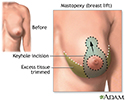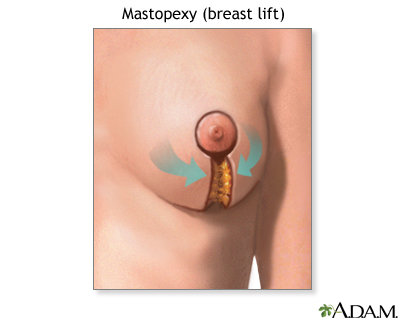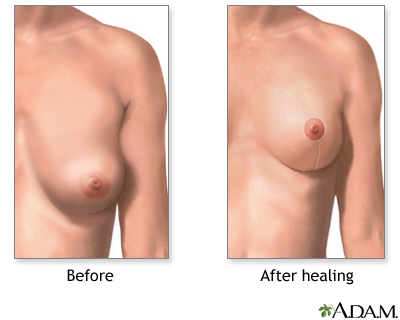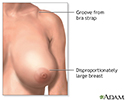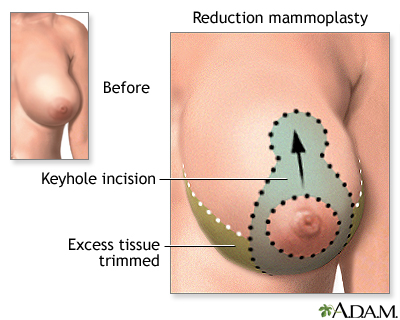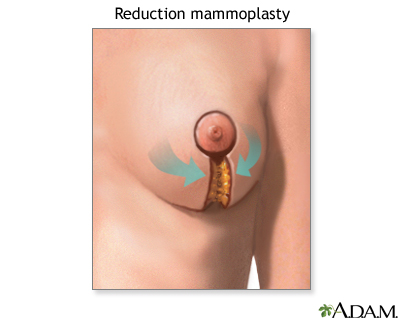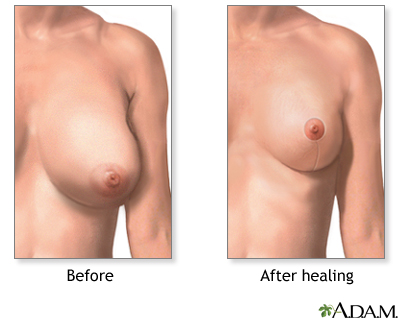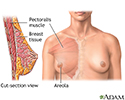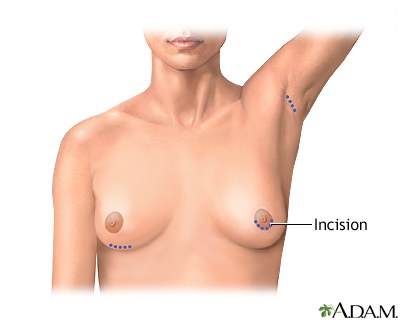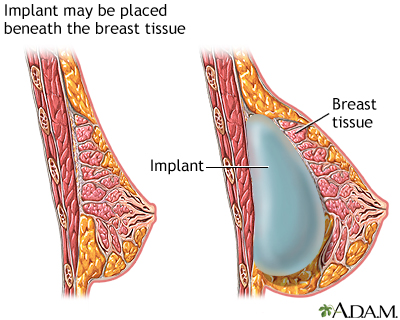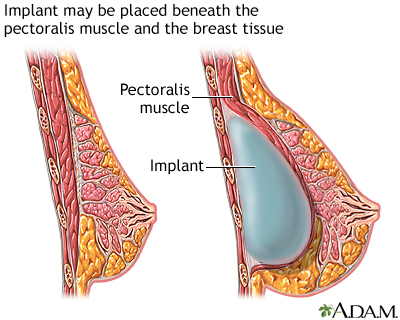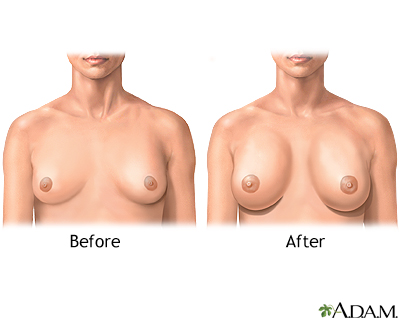Breast augmentation surgery
Breast augmentation; Breast implants; Implants - breast; Mammaplasty
Breast augmentation is a procedure to enlarge or change the shape of the breasts.
Description
Breast augmentation is done by placing implants behind breast tissue or under the chest muscle.
An implant is a sac filled with either sterile salt water (saline) or a material called silicone.
The surgery is done at an outpatient surgery clinic or in a hospital.
- Most women receive general anesthesia for this surgery. You will be asleep and pain-free.
- If you receive local anesthesia, you will be awake and will receive medicine to numb your breast area to block pain.
There are different ways to place breast implants:
- In the most common technique, the surgeon makes a cut (incision) on the underside of your breast, in the natural skin fold. The surgeon places the implant through this opening. Your scar may be a little more visible if you are younger, thin, and have not yet had children.
- The implant may be placed through a cut under your arm. The surgeon may perform this surgery using an endoscope. This is a tool with a camera and surgical instruments at the end. The endoscope is inserted through the cut. There will be no scar around your breast. But you may have a visible scar on the underside of your arm.
- The surgeon may make a cut around the edge of your areola This is the darkened area around your nipple. The implant is placed through this opening. You may have more problems with breastfeeding and loss of sensation around the nipple with this method.
- A saline implant may be placed through a cut near your belly button. An endoscope is used to move the implant up to the breast area. Once in place, the implant is filled with saline.
The type of implant and implant surgery can affect:
- How much pain you have after the procedure
- The appearance of your breast
- The risk of the implant breaking or leaking in the future
- Your future mammograms
Your surgeon can help you decide which procedure is best for you.
Why the Procedure Is Performed
Breast augmentation is done to increase the size of your breasts. It may also be done to change the shape of your breasts.
Talk with a plastic surgeon if you are considering breast augmentation. Discuss how you expect to look and feel better. Keep in mind the desired result is improvement, not perfection.
Risks
Risks of anesthesia and surgery in general are:
-
Reactions to medicines,
breathing problems
Breathing problems
Breathing difficulty may involve:Difficult breathingUncomfortable breathingFeeling like you are not getting enough air
 ImageRead Article Now Book Mark Article
ImageRead Article Now Book Mark Article -
Bleeding
, blood clots, infection
Bleeding
Bleeding is the loss of blood. Bleeding may be:Inside the body (internally) Outside the body (externally)Bleeding may occur:Inside the body when blo...
 ImageRead Article Now Book Mark Article
ImageRead Article Now Book Mark Article
Risks of breast surgery are:
- Difficulty breastfeeding
- Loss of feeling in the nipple area
- Small scars, usually in an area where they do not show much
- Thickened, raised scars
- Uneven position of nipples
- Different sizes or shapes of the two breasts
- Breaking or leakage of the implant
- Visible rippling of the implant
- Need for more breast surgery
It is normal for your body to create a "capsule" made up of scar tissue around your new breast implant. This helps keep the implant in place. Sometimes, this capsule becomes thickened and larger. This may cause a change in the shape of your breast, hardening of breast tissue, or some pain.
Emotional risks of this surgery may include feeling that your breasts do not look perfect. Or you may be disappointed with people's reactions to your "new" breasts.
Before the Procedure
Tell your health care provider:
- If you are or could be pregnant
- What medicines you are taking, including medicines, supplements, or herbs you bought without a prescription
During the days before your surgery:
-
You may need
mammograms
or breast x-rays before surgery. The plastic surgeon will do a routine breast exam.
Mammograms
A mammogram is an x-ray picture of the breasts. It is used to find breast tumors and cancer.
 ImageRead Article Now Book Mark Article
ImageRead Article Now Book Mark Article - Several days before surgery, you may be asked to stop taking aspirin, ibuprofen (Advil, Motrin), warfarin (Coumadin), and any other medicines that make it hard for your blood to clot.
- Ask your doctor which medicines you should still take on the day of surgery.
- You may need to fill prescriptions for pain medicine before surgery.
- Arrange for someone to drive you home after surgery and help you around the house for 1 or 2 days.
- If you smoke, try to stop. Smoking can cause problems with healing. Ask your provider for help.
On the day of the surgery:
- You will usually be asked not to drink or eat anything after midnight the night before surgery.
- Take the medicines your doctor told you to take with a small sip of water.
- Wear or bring loose clothing that buttons or zips in front. And bring a soft, loose-fitting bra with no underwire.
- Arrive on time at the outpatient clinic or hospital.
After the Procedure
You will likely go home when the anesthesia wears off and you can walk, drink water, and get to the bathroom safely.
After breast augmentation surgery, a bulky gauze dressing will be wrapped around your breasts and chest. Or, you might wear a surgical bra. Drainage tubes may be attached to your breasts. These will be removed within 3 days.
The surgeon may also recommend massaging the breasts starting 5 days after surgery. Massaging helps reduce hardening of the capsule that surrounds the implant. Ask your doctor first before massaging over your implants.
Outlook (Prognosis)
You are likely to have a very good outcome from breast surgery. You may feel better about your appearance and yourself. Also, any pain or skin symptoms due to the surgery will likely disappear. You may need to wear a special supportive bra for a few months to reshape your breasts.
Scars are permanent and are often more visible in the year after surgery. They may fade after this. Your surgeon will try to place the incisions so that your scars are as hidden as possible.
References
Hidalgo DA, Spector JA. Breast augmentation. Plast Reconstr Surg. 2014;133:467e-83e. PMID: 24675209 www.ncbi.nlm.nih.gov/pubmed/24675209 .
Maxwell GP, Gabriel A. Breast augmentation. In: Neligan PC, ed. Plastic Surgery . 3rd ed. Philadelphia, PA: Elsevier; 2013:chap 2.
Review Date: 2/10/2015
Reviewed By: Hebe Molmenti, MD, PhD, Private Practice specializing in Plastic and Reconstructive Surgery, Baltimore, MD. Review provided by VeriMed Healthcare Network. Also reviewed by David Zieve, MD, MHA, Isla Ogilvie, PhD, and the A.D.A.M. Editorial team.

